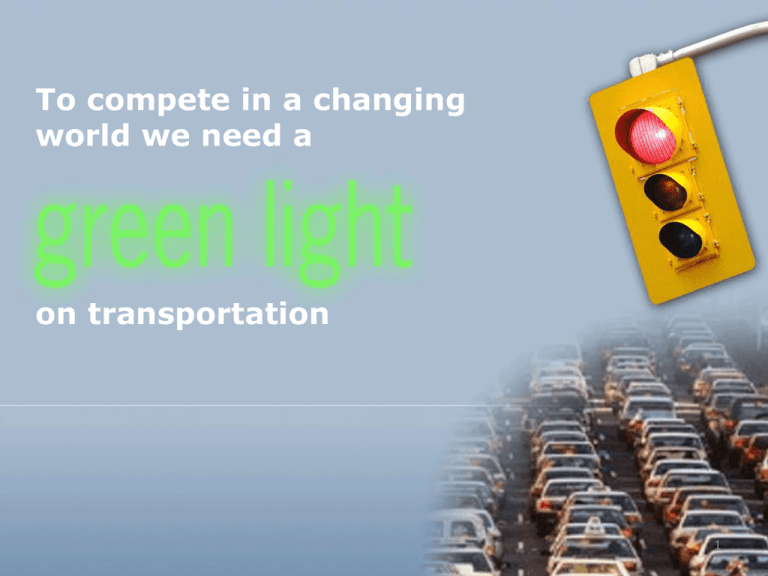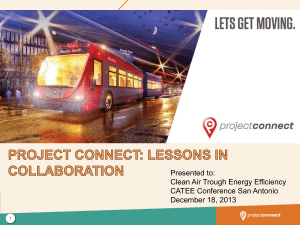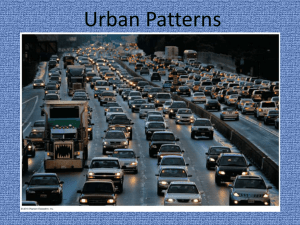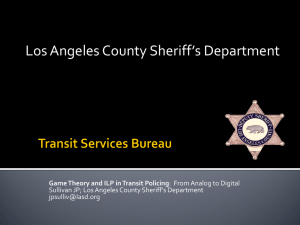of need - Commuter Services
advertisement

To compete in a changing world we need a on transportation 1 Our response was heroic. “Minneapolis bridge collapse highlights aging U.S. infrastructure.” – Times of London, August 2, 2007 Source: Photo from Jeff Wheler/Minneapolis Star Tribune via AP 2 We share important values about our region • Competitiveness • Prosperity • Job growth • Safety • Reliability • Efficiency • Choices • Livability 3 Driving outpaces population growth . . . up 151.0% +40.4% Population1 1980-2000 up 56.0% Trips per day2 1970-2000 1 U.S. Census 2 Metropolitan Council 2030 Transportation Plan 3 Texas Transportation Institute, 2007 Report Miles driven per day3 1982-2005 4 Hours per year stuck in traffic 43 hours 45 40 35 30 25 20 6 hours 15 10 5 0 1982 1985 1988 1991 Source: Texas Transportation Institute 1994 1997 2000 2003 2005 5 Loss of predictability hurts business shipments • • A trip that should take 1 hour, now takes 1 hr., 20 min. But you should plan for 1 hr., 45 min. Source: Texas Transportation Institute 6 We’re getting congested faster than almost anywhere else Hours of delay added per traveler, 1982-2005 Rank 1 Dallas-Fort Worth 48 +480% 2 San Diego 3 Washington, DC 44 +275% 3 Riverside, CA 44 +880% 5 Twin Cities 43 +616% Average, large cities Source: Texas Transportation Institute 45 26 +375% +236% 7 Our increase in travel demand has far outpaced our road capacity and transit service Transportation demand vs. capacity 151% increase 28 million daily vehicle miles of freeway travel 29% increase 1,630 freeway lane miles 1982 2005 14% increase In miles of transit service Sources: Texas Transportation Institute 2005 Urban Mobility Study; Metropolitan Council 8 During a key growth period, Minnesota ranked 48th in transportation investment State funds per capita for roads and transit (capital outlay), 1995-2003 $435 $441 $334 $186 $123 $124 $124 $110 $90 CA OR MN 5 lowest GA MI National average Middle Sources: Federal Highway Administration; Texas Transportation Institute SD WY AK 3 highest 9 Now we’re running on empty • Crosstown delayed again “Requiring contractors to finance . . . Fails to draw bids.” – Star Tribune, June 17, 2006 • Wakota Bridge delayed “Troubled bridge hits new snag.” – Pioneer Press, December 29, 2006 • Property taxes rise . . . “ . . . To make up for transportation shortfall.” – League of Minnesota Cities • 2030 Transit Plan unfunded “ Existing revenue streams simply will not be adequate.” – Metropolitan Council, 2004 10 How do we support our future growth? Total population, 7-county metro region Millions of people 4.0 42% increase in 30 years 3.0 1 million more people expected by 2030 2.0 1.0 0.0 1970 1980 1990 2000 2010 Source: Metropolitan Council 2030 Transportation Policy Plan 2020 2030 11 Last century’s solution won’t work “What would it take to build our way out of congestion? . . . a 70% expansion (adding 1,146 lane miles to the freeway system) by 2020.” – University of Minnesota Would you want to live in a place like this? Source: Center for Transportation Studies, University of Minnesota 12 This century presents new challenges we can’t ignore Energy insecurity Climate change New solutions Source: Photos from: National Renewable Energy, U.S. EPA, www.transitorienteddevelopment.org 13 Minnesota has a transportation strategy Catch up on roads and bridges Add transit and other choices Build communities designed for less driving Source: Photos from: www.okroads.com, www.lightrailnow.org, Ben Garvin, New York Times 14 We have a road investment plan Relieve bottlenecks 94 and 694 494 and 169 280 35E and 94 55 35 Source: MnDOT 169 and County Road 81 52 15 We have a road investment plan Finish roads begun but not yet completed 35W and 694 610 5 Wakota Bridge 212 77 Source: MnDOT 3 16 We have a road investment plan New lanes to build capacity where needed 10 35W and 35E north of 694 394 36 169 from 494 to I94 62 494-694 beltway 55 Source: MnDOT 17 We have a transit plan Three transitways are up-andrunning or in active development NorthStar Central Hiawatha Source: Metropolitan Council 18 We have a transit plan Seven others are in early development, but there’s no state funding available . . . Rush Line Bottineau Boulevard I-394 Southwest I-35W (UPA) Source: Metropolitan Council Red Rock Cedar Avenue 19 We have a transit plan A complete transit system . . . Source: Metropolitan Council 20 Build communities designed for less driving Maple Grove Arbor Lakes Woodbury Lakes St. Louis Park Excelsior and Grand Burnsville Heart of City Source: Photos from: www.richardcooper.com, edenprairieweblogs.org 21 Metro shortfall: $984 million a year $1.5B $1.2B $332M $330M $186M Needed for roads Needed for transit Total need Funding expected New MVST revenue $984M Our annual shortfal l 22 The consequences of not acting . . . “Funding at current levels will result in significant increases in traffic congestion, delaying the movement of people and goods, reducing the region’s economic competitiveness, and harming our quality of life.” – Metropolitan Council 2030 Transportation Plan Last revised 2004 23 What others have done 47 states Denver Raised gasoline tax since Minnesota last raised its tax 20 years ago Denver added 0.4¢ to sales tax for 12 years to raise $4.7 billion for transit Phoenix Extended half-cent sales tax for 20 years to raise $16 billion for rail, buses, and roads San Diego Extended 1/2-cent sales tax for 20 years to raise $9.5 billion for rail, buses and roads Salt Lake City Added 1/4 cent to sales tax for 10 years to raise $2.6 billion for 10 years to build 4 new light rail lines and commuter rail Sources: American Petroleum Institute; local transit agencies 24 Funding the Metro plan Potential actions to solve our $984 million a year shortfall Metro need $984M Shifting current revenues Adding new revenue Managing future demand 25 Funding the Metro plan Potential actions to solve our $984 million a year shortfall Metro need $984M Shifting current revenues Annual yield % of need M.V.S.T.1 $183 million Leased vehicles1 $ 28 million 4% Rental cars2 $ 28 million 3% Property tax increments2 $ 1 MN Revenue Department 2 Senate Transportation Committee staff ? million 19% ?% 26 Funding the Metro plan Potential actions to solve our $984 million a year shortfall Metro need $984M Adding new revenue Annual yield % of need 29% Extend sales tax to clothing1 $283 million Extend sales tax to gasoline1 $235 million 24% ½ cent sales tax increase2 $225 million 23% License tab fees1 $ 75 million 8% Nickel gas tax increase1 $ 69 million 7% Wheelage tax1 $ 40 million 4% Index gas tax $ 1% 1 MN Revenue Department 9 million 27 Funding the Metro plan Potential actions to solve our $984 million a year shortfall Metro need Adding new revenue $984M Annual yield % of need Levy tax on emissions Levy tax on “free” parking spaces Leasing roads and bridges to private companies Mileage tax 28 Funding the Metro plan Potential actions to solve our $984 million a year shortfall Metro need Managing future demand $984M Annual yield % of need Road pricing Life style and community 29 Bonding can be a part of the solution Bonding can accelerate high-priority projects, but should not be viewed as adding "new money" to the transportation solution. Bonding is borrowing money that must be paid back with interest. 30 Investing in transportation is investing in the future of the Twin Cities We need a 21st century transportation system to • Stay competitive • Enhance our quality of life • Fulfill our potential for future generations 31 What can you do? • • Share this presentation • • Talk to your friends and neighbors Tell your state political leaders that now is the time to act Write letters to local and community newspapers Information in this presentation was assembled by ULI Minnesota, the Regional Council of Mayors and the Itasca Project www.minnesota.uli.org 32 To compete in a changing world we need a on transportation 33





